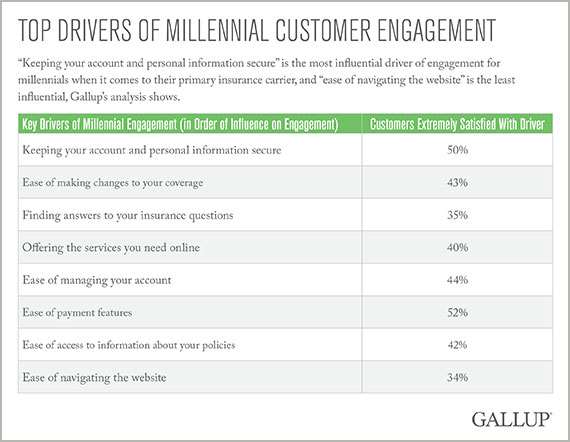Story Highlights
- Millennials are least likely group to be engaged with insurers
- Millennials are more than twice as likely to buy online
- Millennials' families influence their choice in insurers
When it comes to engaging their millennial customers, insurance companies have their work cut out for them. Of all the generations, millennials (born in 1980 to 1996) are the least likely to be fully engaged -- and the most likely to be actively disengaged -- with their primary insurer.
This has serious implications for insurance company leaders. Millennials are the largest generation in the U.S. and will grow to dominate the market in the years to come. Insurance executives who neglect to take steps to engage this age group do so at their own peril.

Insurance companies see substantial business gains when they engage customers of any generation, Gallup finds. Compared with their actively disengaged counterparts, engaged insurance customers are less sensitive about pricing when selecting and retaining a primary insurance carrier. They spend more and buy a wider variety of products, including financial offerings, from their insurer than do actively disengaged customers. They also stay with the company longer and are more likely to recommend it to others.
But building and maintaining customer engagement can be challenging -- especially for insurance companies with a diverse customer base. To raise millennials' engagement -- and ensure a more engaged customer base in the future -- leaders first must understand how these young customers differ from others in their engagement and consumer behavior.
In its 2014 Insurance Panel study, Gallup uncovered insights into what drives millennials to start a relationship or stay in one with an insurance company. This analysis revealed many similarities across generations, but it also uncovered two important avenues insurance companies can take to build relationships with millennials.
1. Family is key. Millennials are significantly more likely than other generations to have insurance coverage under a family member who chose the company. When their family members value an insurance company's brand, millennials follow suit. This finding contrasts sharply with older generations' prioritization of factors such as cost and company reputation over family preference.
By building loyalty with Generation Xers and baby boomers, insurance companies can improve millennial customer acquisition and retention. And by thinking strategically, insurance companies can reach millennials through older generations of customers.
2. Millennials are more likely to buy insurance online. Another important distinction among generations is that millennials are more than twice as likely (27% vs. 11%, respectively) as all other generations to purchase their policies online rather than through an agent. Online purchasing is far from the mainstream among insurance consumers overall -- 74% originally purchased with an agent vs. 14% online -- but if this trend among millennials continues to grow, it could substantially change the way insurance companies interact with customers in the coming years.
Unfortunately for insurance companies, millennials are least satisfied of any generation with the online experience, and this could be one of the reasons for this tech-driven age group's low engagement overall with their primary insurer. For insurance company leaders, this means improving interactions with customers online is a smart investment toward building strong relationships within this future mainstream customer base.
How to Engage Millennials Online
Gallup's study identified specific elements -- or drivers -- of the online experience that can help insurance companies improve customer engagement among millennials. When customers are extremely satisfied with a driver, it translates into a significant increase in the percentage of fully engaged customers.
The challenge for insurance companies is that no more than one-third to one-half of millennial insurance customers are extremely satisfied with any of the eight drivers Gallup studied. By focusing on these drivers, particularly on the most influential ones, such as "keeping your account and personal information secure" and "ease of making changes to your coverage," insurance companies can engage more of their millennial customers and reap the business benefits of doing so.

As insurance companies think about ways to improve their relationships with their millennial customers, the following are some key areas to manage:
- Family incentives: Insurers can leverage existing relationships with members of older generations who can reach out to their millennial family members. By giving incentives to baby boomers and Generation Xers to add policies for millennial relatives, insurers have a good chance of not only gaining new customers but also engaging entire families.
- Specialized services: Older generations would likely appreciate insurers' extra efforts to take care of the millennial customers in their families. Insurance companies can engage multiple generations by prioritizing care of millennials in both their product offerings and customer service -- and communicating this to millennials and their families.
- Information security: Millennials -- and all customers -- want to know their account and personal information is safe. This is the most important driver for this generation. Insurance companies should focus on providing top-of-the-line online security to boost engagement. By offering security education to customers and keeping them up-to-date on the steps they can take to improve security, insurance companies can make the most of this engagement driver.
- Ease of making changes to coverage online: To millennials, convenience, functionality and speed are key to the online experience. And compared with other generations, they encounter significant life changes with greater frequency. Being able to quickly and easily make changes to coverage online is another strong engagement driver among millennial customers.
- Finding answers: Tech-savvy millennials frequently turn to the Internet when they have a question. It's important to millennials that the answers to their insurance questions are easy to find and simple to grasp. Making information readily available online and providing other resources, such as live chat, are smart ideas for meeting this millennial need.
- Access to various services: Millennials are capable of and comfortable with getting things done electronically. And they want to accomplish things online -- even potentially complicated tasks, like purchasing new products. Equipping millennials with everything they need through multiple channels is a great way to build engagement.
- Ease of use: Ease of account management, payment features, access to policy information and site navigation are also engagement drivers among millennials. When it comes to online experiences, they have high expectations because they likely interact with several companies across a variety of industries. Keep it speedy, straightforward and sharp.
Millennials are the largest generation in the U.S., but many are just entering adulthood -- so the full force of their impact is yet to be felt in the marketplace. By specifically and tactically addressing this generation's unique needs, insurance companies can provide better service and make a strong investment in engaging their future mainstream customers.
Survey Methods
Results are based on a Gallup Panel Web and mail study completed by 18,039 national adults, aged 18 and older, conducted Dec. 4, 2013, through Jan. 14, 2014. The Gallup Panel is a probability-based longitudinal panel of U.S. adults who Gallup selects using random-digit-dial phone interviews that cover landline and cellphones. Gallup also uses address-based sampling methods to recruit Panel members. The Gallup Panel is not an opt-in panel, and members do not receive incentives for participating. The sample for this study was weighted to be demographically representative of the U.S. adult population, using 2012 Current Population Survey figures. For results based on this sample, one can say that the maximum margin of sampling error is ±1 percentage point, at the 95% confidence level. Margins of error are higher for subsamples. In addition to sampling error, question wording and practical difficulties in conducting surveys can introduce error and bias into the findings of public opinion polls.
Bailey Nelson contributed to the writing of this article.

